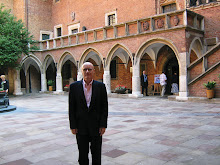“Vacationing at Auschwitz” II
Alex Perry writes a very informative and thoughtful essay, “Vacationing at Auschwitz” in a recent issue of Time Magazine on the subject of visiting Auschwitz. See his article on line in the current issue at
http://www.time.com/time/world/article/0,8599,1630425,00.html?xid=site-cnn-partner
Auschwitz is one of those places off the usual tourist map as it is a place of magnified horror and shock, yet it is also the most memorable place on earth that I have been to, and only for a few hours. Often, especially when teaching about the Holocaust, I revisit the walk I made with students and friends from Milwaukee to this notorious “secret prison” of the Third Reich.
Walking under the “Arbeit Macht Frie” is a chilling experience, yet it is also odd to see tourists from around the globe wondering through the brick army barracks that comprised what was once Auschwitz I, a Polish army camp that became a center of torture and brutality shortly after Poland was overrun by its neighbor/enemy. A number of the buildings offer a glimpse into the death camp, with displays of collected articles from the prisoners who arrived by the hundreds of thousands, day and night, month by month, year by year between 1941 and 1944-45, though I am not sure when the last train arrived in the last year of the War. By the time you finish a guided tour any visitor has a good clear sense of what happened here, and one can even walk by and even enter the first or “experimental” gas chamber and crematorium, though it has been reconstructed for tourists to have a “walk through.”
About a 3 minute or so bus ride away is the larger camp, Auschwitz II, which was expanded and magnified into one of the largest and efficient death camps of World War II. Without any trouble, you can take a picture of the classic structure of the main gate of Auschwitz II. Inside, it is quite remarkable, as today it looks like an open field with tens of tiny chimneys which to a new tourist, might be mistaken for the notorious five chimneys that sent 1.5 million men, women and children floating into the sky, or drifting down the river, or simply as field fertilizer. But they are only heating units of the countless number of barracks used in the 40’s for “housing.” I still can recall walking into a women’s barracks thinking that I might experience something, but it was quite clean, all the feces and urine had been washed away, and no one was screaming or moaning. No one was dragged away after a selection. I was safe.
At the very end of Auschwitz II, which might be a 30-40 minute walk, depending on your willingness to wonder through such a tranquil and peaceful field, you will come to the destroyed five chimneys and gas chambers though you can’t walk through any of it, unless you are looking for something like a bone or a scraping of Zyklon B. What is most memorable is the memorial plaque which explains, briefly, that 1.5 million Europeans were murdered here as a “final cleansing” of Nordic stock. By the time you kneel or rest at this memorial site, you probably are either tired, thirsty, or deeply saddened. I know I was. The sadness has lifted, but I am always remembering this place as one of the most unimaginable places on earth.
This blog provides a brief glimpse of the life of a retired professor of English, with topics ranging from the state of poetry, religion and philosophy, yoga, older athletes and who knows what else might develop. Send a comment if you wish to: clintond@uww.edu
DeWitt Clinton

DeWitt Clinton
About Me

- DeWitt Clinton
- Milwaukee, Wisconsin, United States
- DeWitt Clinton has just finished a long career of teaching and mentoring students at the University of Wisconsin—Whitewater, USA. His essay on travelling in Poland has just appeared in Cultural Studies<=>Critical Methodologies. His newest poetry collection is an adaptation of Kenneth Rexroth’s 100 Poems from the Chinese. A few poems from this manuscript have appeared in Cha, qarrtsiluni, and Verse Wisconsin.